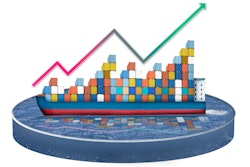
As supply chains extend globally, they become more complex. The flow of supplies, finished goods and information are widely distributed, presenting significant challenges across a manufacturer’s entire supply chain network of customers, suppliers and logistics providers. For success, companies need to gain visibility into this complex supply chain network to collectively sense and properly respond to changes in supply and demand.
End-to-end supply chain visibility is a key to becoming a demand-driven enterprise. Companies need to implement a visibility and collaboration solution, from their supplier’s dock through to their customer’s dock, to gain insight. Enterprises gain significant benefits by collaborating with their supply chain trading partners through supply chain operating networks. According to industry analyst group Gartner, end-to-end supply chain visibility will increase by 50 percent by 2018.
Below are some tips on how to enable end-to-end visibility across your enterprise:
- Sensing and responding are critical processes for supply chain visibility, and can only be achieved through a collaborative network that is coupled with robust business process orchestration and advanced analytics.
- Visibility encompasses not only sensing data, but also how to analyze it and take appropriate action across the extended enterprise. Next-generation business ecosystems—like a supply chain operating network, in which commerce is digitized and flows across buyers, suppliers and logistics providers—is key to enabling future-looking capabilities. As the applications operate on the transactions, and all of the data is stored in a very accessible way (and in a way that can bring in outside data feeds like economic data, weather forecasts, etc.), it can then be pulled together to deliver the type of game-changing analytics that illuminates the meaning behind the data.
- Use predictive and prescriptive analytics to support your visibility goals. Predictive analytics give supply chains the ability to respond to actual market conditions, predict consumer behavior and identify possible delivery constraints. In business, predictive models exploit patterns found in historical and transactional data to identify risks and opportunities. Models capture relationships, among many factors, to allow assessment of risk or potential associated with a particular set of conditions, guiding decision-making. Examples include using weather data to predict buying behavior or potential supply disruptions, forecasting future demand, predicting the price of fuel, and sensing transportation hub congestions and dynamically rerouting to less congestive ports. Prescriptive analytics envision many different scenarios using intelligence gathered in real time and presents an optimal solution. Prescriptive analytics help companies decide the best course of action to take given certain business objectives, requirements and constraints. It seeks to find the optimal solution given a variety of choices, alternatives and influences that may affect the outcome. Descriptive, predictive and prescriptive analytics should coexist. One is not better than the other, they are just different. All of them are necessary to contribute to an organization’s goal of improved and more informed decision-making.
- Eliminate silos within your organization to take full advantage of end-to-end visibility. Typically, companies operated in silos, but according to a recent Global Supply Chain Institute at the University of Tennessee survey, while some lines between business functions blurred, some silos still exist, especially between purchasing and logistics. In a key part of the study, a number of purchasing and logistics professionals acknowledged pitfalls resulting from their lack of collaboration, ranking performances below expectations in areas that required the two groups working together. Best-in-class companies tend to have end-to-end supply chain integration encompassing procurement, planning, transportation, warehousing, engineering, research and development (R&D), quality, etc. Stakeholders in each area should report to the same person, and work with common metrics, vision and reward systems. Without integrated decision-making, financial performance is going to most probably be affected.
- Create an outside-in way of thinking within your organization by focusing on customers and trading partners instead of internally. The reality is that manufacturers can’t expect all their customers, suppliers and logistics providers to collectively adopt a single process. When companies can operate their supply chains to respond directly to external market drivers, this is known as the outside-in supply chain. This enables companies to focus more on sensing, shaping and driving an intelligent response to the environment happening outside their internal control.
- Utilize cloud-based shared process and information layers within your information architecture to sit above physical assets, and supply chain and operational applications. The cloud can be a real game-changer for supply chain applications, allowing greater connectivity, which leads to greater collaboration. The cloud allows for connections to be made rapidly and at a lower cost, opening the door for richer connections to be made—and to be made faster.
- Make it easy for trading partners to connect by eliminating barriers to onboarding. A recipe for unmet expectations occurs when businesses attempt to force trading partners to collectively adopt a single process or technology standard. Individual companies each have their own processes and enterprise requirements. While internal needs can be forced through by corporate mandate, external supply chain partners are not necessarily accepting of demands. A supply chain operating network truly integrates the extended, varied, distributed and complex needs of thousands of individual trading partners and their respective enterprises, without requiring any of them to change the way they do business.
Gaining end-to-end supply chain visibility provides significant benefits, such as higher order fulfillment rates, improved customer service levels, higher profitability, increased operational efficiency and higher revenue growth. Using a supply chain operating network that offers collaboration and visibility capabilities, your company can experience better on-time performance, reduce variability in lead times and free up working capital.
Per Gartner, the quantitative benefits include:
- Inventory savings of 20 percent of value.
- An increased forecast accuracy of about 25 percent.
- Improved service-level agreements to consistent 98 percent levels.
- Freight charge reductions from 5 to 3.5 percent of volume.
- A decrease of inventory on stock from just over 10 days to fewer than seven days.
- A reduction in workforce by 10 percent.
- An implementation return on investment of only one year.
With end-to-end supply chain visibility, your business can respond more quickly to demand changes and be better positioned to beat the competition. It is suggested that demand-driven companies can sense market changes five times faster, which enables better customer service, lower inventory and better bottom-line profits.













